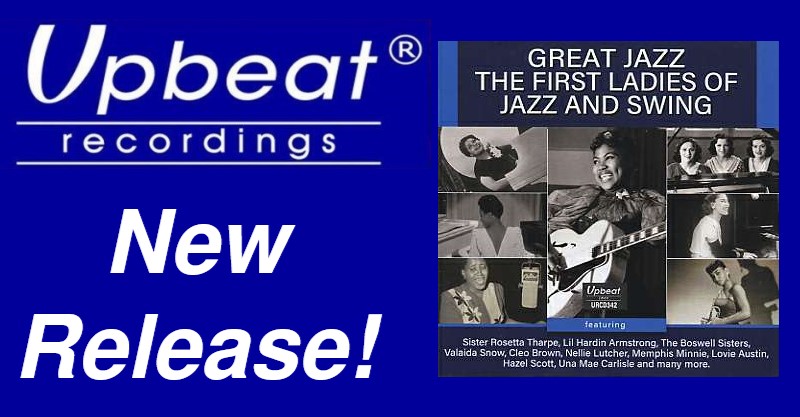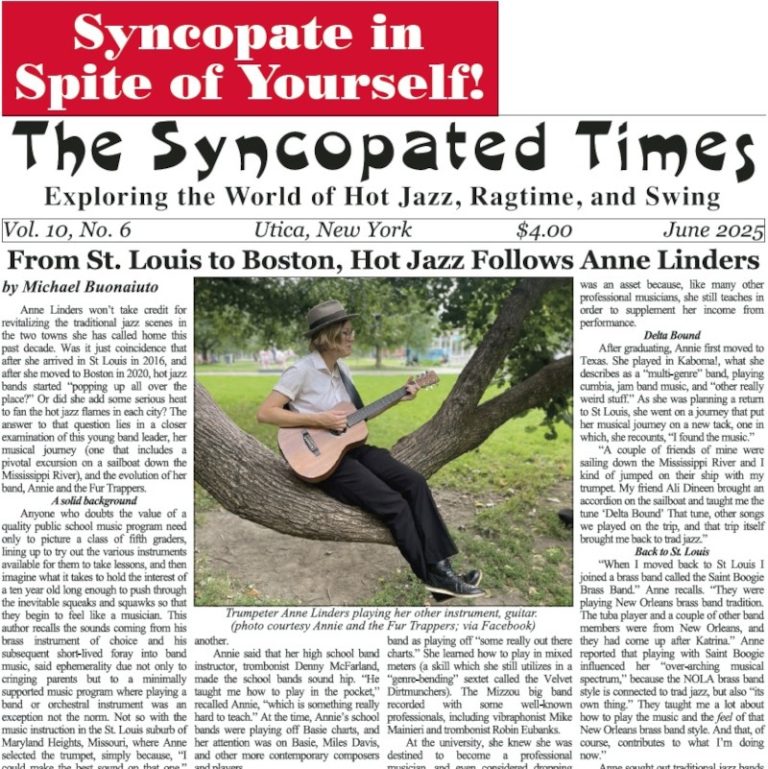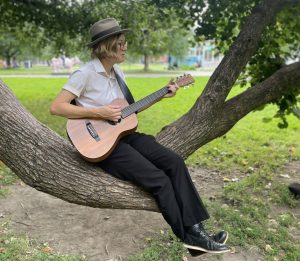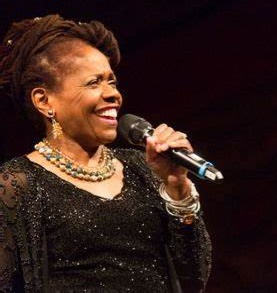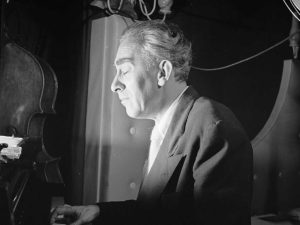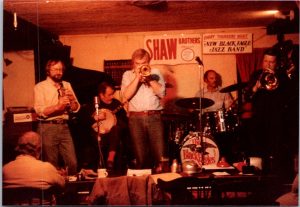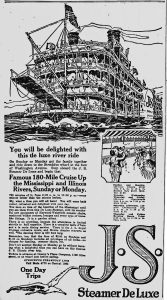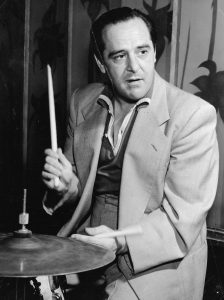Reedman and jazz scholar Dan Levinson is poised to celebrate the one hundredth anniversary of recorded jazz this year with a series of concerts featuring his Roof Garden Jass Band. He sees February 26, 1917, when the Original Dixieland Jass Band entered the Victor studio in New York to record “Dixie Jass Band One-Step” and “Livery Stable Blues,” as the day popular music changed forever.
Some claim as the first jazz record can be made for “My Hawaiian Sunshine” recorded by Wilbur Sweatman for Emerson in December 1916, as well as “Too Much Mustard” (Victor 35359) by Europe’s Society Orchestra from December 29, 1913. There was also a popular song by Gus Kahn and Henry I. Marshall, “That Funny Jas Band from Dixieland,” recorded by Arthur Collins and Byron G. Harlan (Edison Diamond Disc 50423) on December 21, 1916. But the Original Dixieland Jass Band represented something entirely new.
“They had a sound unlike any other band on record at that time,” says Levinson. “You could say Wilbur Sweatman is jazz, you could say Jim Europe is jazz—but whatever the ODJB was, it was different. It had something that took the country by storm.” That first record, he says, “is what made jazz popular.”
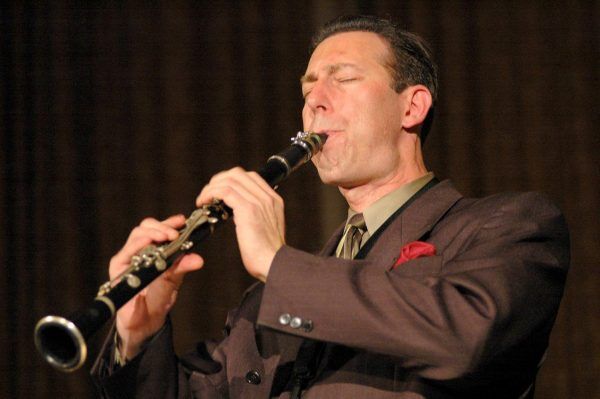
The band (whose personnel in 1917 consisted of Dominic “Nick” LaRocca, cornet; Eddie Edwards, trombone; Larry Shields, clarinet; Henry Ragas, piano; and Tony Sbarbaro, drums) had been working in Chicago as “Stein’s Band from Dixieland,” having come up north from New Orleans. “While they were in Chicago that’s where supposedly they developed their style that became jazz music—what they considered to be jazz. At least that’s what they maintained.” An early fan of the band was Al Jolson, and he invited them to New York to open at Reisenweber’s Café on Columbus Circle.
“They were a sensation there,” says Levinson. “It didn’t start off well—people didn’t know quite what to make of the music. They’d never heard anything like it. The manager got up and said, ‘Ladies and Gentlemen, this music is for dancing.’” The patrons soon got the idea. The ODJB played all the popular dance rhythms of the day: fox-trot, one-step, and even waltzes.
Soon, restaurants all over New York were removing tables to make room for dancers, and hiring their own “jazz” bands. “Most them were ‘hot dance’ bands—they didn’t measure up to the ODJB. There was Earl Fuller, and the Frisco Jazz Band, who made some records for Edison—but it’s really not the same thing.” It was an attempt, at best, to imitate that style.
The ODJB “had something that really mesmerized the public. In those days it was much freer than the written music that other bands were playing. Those guys played without written music. In fact, only one of them could read music: the trombonist, Eddie Edwards.
“The era of the great improvised jazz solo was yet to come. These guys didn’t have any idea that years later jazz aficionados would be judging them on their improvisational ability, because then it was all about playing hot dance music.” To some, says Levinson, “It sounds like they’re playing the same thing on every successive chorus. They didn’t take solos except for the two-bar breaks in the middle of a chorus. You don’t really hear any kind of solo instrument at all. It was all ensemble.”
That made playing a daunting challenge for the musicians. Today, it’s almost unheard of for all musicians on a gig to play in ensemble all the time. So when Dan Levinson does a concert with the Roof Garden Jass Band in full ODJB mode, “it’s a chop buster. We’re used to playing a chorus, maybe two choruses as a group and then going around and everybody plays solos. These guys played all ensemble all night long, and they played maybe eight hours a night, seven days a week. They had iron chops.” But it was dance music—and the band was there to keep the dancers happy. “The dancers weren’t there to hear improvised solos.”
The Columbia Graphophone Company approached the band first, when they were still packing the dance floor at Reisenweber’s. Columbia set up a date in January, 1917. “It was disastrous. Supposedly, according to recollections of the musicians, the engineers could not get a good balance between instruments. One account says that there were construction workers working on another part of the studio and they started banging their hammers, and the session had to be trashed. They couldn’t get anything out of it.”
Enter the Victor Talking Machine Company. The ODJB was invited to the brand new Victor studio on the 12th floor at 46 West 38th Street to record the “jass” they were playing at Reisenweber’s. Victor had innovative engineer Charles Sooy record the band, and “he experimented with moving the musicians into different areas of the room, so they were all spread out. They also strung a bunch of wires across the ceiling to deaden the sound so it wouldn’t reverberate. They had the clarinet and the piano right up next to the tin pickup horn. This was before microphones, of course.
“They had two horns—a big one and a little one—and the little one was pointed down at the piano which was right next to it, and the clarinet was next to the piano. And then the trombone was further back, and the trumpet was behind the trombone, and the drums were all the way on the other side of the room. So they were not ideally placed for hearing each other—it became an unforeseen challenge to hear each other while they were playing. That’s where Sooy had to place the band in order to get a decent balance. And with that you still can’t hear the cornet. You hear a lot of clarinet on those early Victors—and not so much cornet. And barely any piano at all, even though it’s right underneath the pickup horn. You hear a lot of drums.”
But Charles Sooy succeeded in capturing the sound of the band. “They recorded two titles that day, ‘Dixie Jass Band One-Step,’ which today is known as ‘Original Dixieland One-Step,’ and they recorded ‘Livery Stable Blues.’”
Victor 18255 was approved—and issued just nine days after being recorded, on March 7, 1917. “There was an explosion. It sold over a million copies in a few months. It surpassed John Philip Sousa and Enrico Caruso who were then the top-selling artists at Victor. It set a new sales record for the company. This was unprecedented.
“And suddenly jazz had swept the country—and not only the country, the world. Suddenly people on the other side of the world could hear this music called ‘jass.’ And bands sprung up all over the world attempting to replicate that sound. It was a number of years before anybody could do that.”
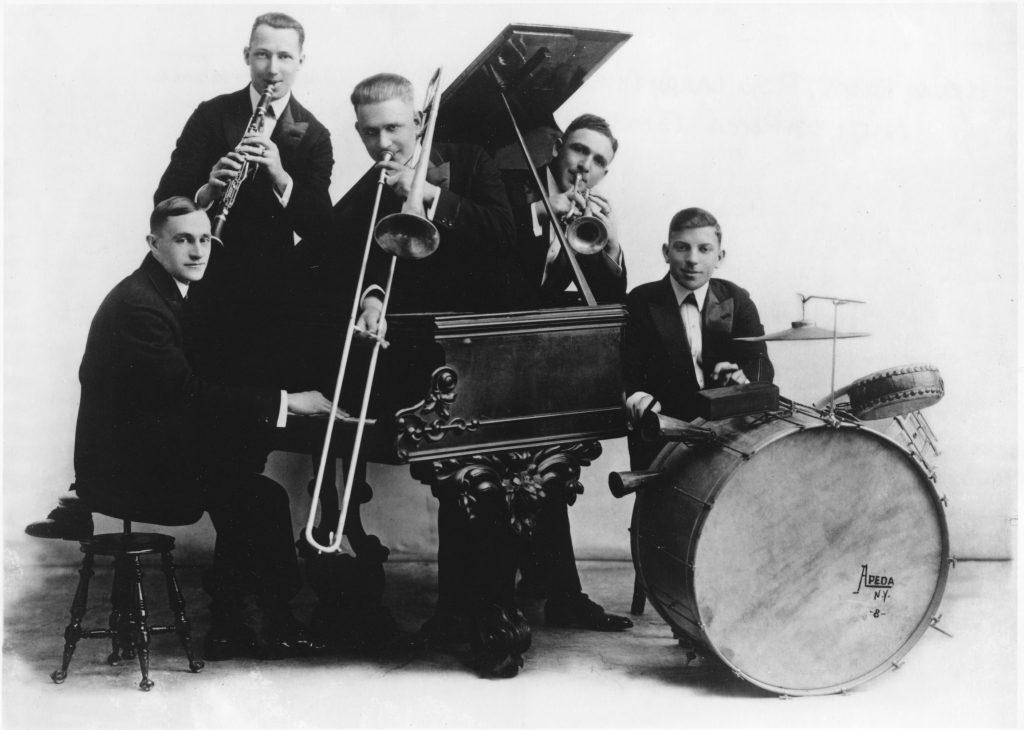
Dan Levinson suggests that the Original Memphis Five were the next band to record that caliber of jazz—they made their first records in 1921, four years later, as Lanin’s Southern Serenaders and Ladd’s Black Aces. Before then, he says, “you don’t really hear anything on record that sounds like that and had that kind of an impact on the record-buying public. And they were all New York studio musicians, despite their name and the various pseudonyms they used.
“For a few years the ODJB was the only thing of its kind. They got an offer in 1918 to go to London. They went off to London and they played at the Hammersmith Palais and they made a bunch of records on English Columbia. Many of those were pop tunes of the day as opposed to their own compositions, which became jazz standards still played today.”
The centenary of the first jazz record has a personal significance for Dan Levinson. In 1987, in celebration of the seventieth anniversary of the ODJB’s landmark session, he organized his first concert as a leader to re-create the raucous music that changed the world. “And that was the first time I had ever performed this music—but it was also the first time I had ever performed in front of an audience other than sitting in with a few bands.
“I went all out for this concert. I had just graduated from NYU and I was able to get their auditorium, the Eisner and Lubin Auditorium at the Loeb Student Center. They gave me the room—I didn’t have to pay for it—and I went about organizing this concert. I had a guy help me with promotion. I’ve never done so much promotion in my life. We sent out fliers and press releases to hundreds and hundreds of newspapers, magazines, radio stations—everything.
“And it paid off. It sold out. John S. Wilson, the jazz critic of The New York Times, showed up and gave the concert a rave review. My very first concert ever.”
Levinson concedes there was an element of beginner’s luck. “There was nowhere to go but down from there—I could never top that. We did all the promotion, and all the hoopla about the first jazz recording. At the time I was just short of my twenty-second birthday, so I was still twenty-one and I had started playing clarinet in 1985, so I’d been playing two years and I sounded like it. I was out of tune, I didn’t really know how to play the instrument, and I was just struggling to get by. I didn’t even know how bad it sounded, because my ears weren’t developed at the time.
“In retrospect, because I have a recording of it, I sounded pretty bad. But nobody complained about it—at least not to me. And, in fact, at that time I was still not tolerated by the jazz community here in New York. I wasn’t there yet. And I couldn’t improvise. I had memorized what Larry Shields played. I was playing parts that I’d memorized. I developed my improvisation over the next few years.
“And I didn’t read music, I didn’t improvise, I just memorized this stuff. It’s all I worked on for six months. And it paid off.”
Band members for that first concert came in from all over. Two musicians flew in from Los Angeles: cornetist Dick Miller and trombonist Keith Elliott, who both worked with the legendary James “Rosy” McHargue. Rosy, who remained an active musician and jazz preservationist well into his nineties, was a mentor, hero, and best friend to Dan Levinson. “Rosy himself had learned to play clarinet by copying the records of the ODJB and Larry Shields’ clarinet parts when they came out in 1917. He was born in 1902. So at the age of 15 he heard these records and was blown away like the rest of the public. He sat down with his ear to the Victrola and somehow memorized what Larry Shields played.
“He introduced me to the ODJB. I’d heard records of them, but he really sung their praises and guided me in terms of the importance of that band—its significance and uniqueness. And I began, with his encouragement, to transcribe their records with the intent of putting on a seventieth anniversary concert.”
Pianist on the date was Tom Rexdale, a professor at NYU whom Levinson had heard playing ragtime in a practice room on campus, and he invited him to take part in the concert. The drummer was long-time percussionist for Vince Giordano’s Nighthawks, Arnie Kinsella. An alto saxophonist, Andrew D’Angelo, was added to play the Bennie Krueger parts heard in the later ODJB recordings.
“And that was my band. Nobody knew who I was at the time. I was just some upstart who came on the scene and was making his name playing re-creations of ODJB music. I did a few things after that, nothing really on that scale—I did a repeat concert on the West Coast in January 1988 in the Roof Garden ballroom at the Variety Arts Center in Downtown Los Angeles. And Rosy McHargue was the saxophonist on that date.” Miller and Elliott were again in the band, as was pianist and pop-music revivalist Ian Whitcomb. The drummer was Larry Fisher, who worked with the Jazzin’ Babies jazz band.
Levinson named his ODJB revival group the Roof Garden Jass Band in honor of the venue. “They had a ballroom on the top floor which was extravagantly designed. It looked like a ballroom from the Ragtime Era.”
The beginner’s luck of that first heady concert at NYU began to fade. “We did play at the 92nd Street Y for Dick Hyman’s Jazz in July Festival in 1989, with Vince Giordano on for the second half of the concert. And we got a terrible review. That review was more in line with what we really sounded like. It was not pleasant. It was my first bad review—and considering that it was only my third review, I wasn’t doing too badly.”
Afterward, Dan Levinson went off to live in Paris for a year. “I kind of got things together, in 1990, ’91.” He worked in Paris with cornetist Dick Miller who had put a band together there. The time spent in a working band proved salubrious to Levinson’s technique and ear. “When I came back, I played a Seventy-fifth Anniversary of Recorded Jazz concert at the same place—in the Eisner and Lubin Auditorium. And Jon-Erik Kellso, whom I’d known since 1989, played cornet on that. The pianist was a guy named Regan Ryzuk, the drummer was Bruce Chaffin, the trombonist was Dan Toomey who was playing with the Paragon Ragtime Orchestra. For that concert, when we did the numbers that had originally included saxophonist Bennie Krueger, I played alto sax and I got Paul Garment to play the clarinet parts. That was my band in 1992.”
Levinson didn’t do much with the ODJB repertoire for another five years. “In 1997, I got together with Tom Roberts, David Sager, Kellso, and a young drummer I’d just met a couple of years before that who was making his name around New York City, Kevin Dorn.” The group started doing concerts as the Roof Garden Jass Band. “And that’s really when things got going.”
They booked gigs at jazz societies all over the Northeast. “Dick Moore, of the Hot Steamed Jazz Festival, said, ‘We’d like to have you play for us at our festival in June—but it would be great if you had a CD.’ That was in January or February 1998. By March I had organized a recording session. We recorded the CD in March, and almost as quickly as the Victor Talking Machine Company released that first record, I was able to get that CD out—manufactured, with liner notes by the author of the book on the ODJB, The Story of the Original Dixieland Jazz Band, H.O. Brunn.”
The Roof Garden Jass Band, says Levinson, “was my band—my only band, under my name. I had worked with other bands, of course. I worked with Vince Giordano, the Flying Neutrinos, and I was working with Leon Redbone. Tom Roberts and I were Leon Redbone’s band. He and I toured with Redbone for about six years.”
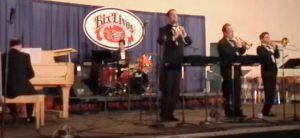
The Roberts-Sager-Kellso-Dorn edition of the Roof Garden Jass Band “lasted about ten years—from the eightieth anniversary to the ninetieth anniversary. During that time, Jon-Erik Kellso became a superstar—he was very hard to nail down. David Sager lived (and lives) in Maryland, Tom Roberts lives in Pittsburgh, so it was hard to do local things with that band. It was very hard to get them together. Living in different places, it became somewhat of a challenge.
“We did our ninetieth anniversary concert in 2007—and I couldn’t even get Kellso for that.” They did one more performance for the Orange County Classic Jazz Society, and that was it. Getting the musicians together in one place was just too difficult. Dan Levinson decided to retire the band.
Then, three years later, percussionist Josh Duffee was booking music for the Bix Beiderbecke Memorial Jazz Festival in Davenport. Duffee asked Levinson to get the band together for the Bix Fest. “And I was able to get those guys.” But there were no further engagements scheduled. “That was 2010. we did one performance.”
By that time, Levinson had other working bands: the Canary Cottage Dance Orchestra, the Swing Wing, Fête Manouche—all with different personnel, based on who was available for a particular date. In addition, Molly Ryan—Mrs. Dan Levinson—had become a popular jazz vocalist, with her husband often as accompanist. “There was a lot going on and I really didn’t have the time to invest in marketing the Roof Garden Jass Band.
“And then I met trumpeter Mike Davis. When I met him he was a student at the Manhattan School of Music, and he was jazz crazy. He loved Nick LaRocca, he loved the ODJB. He did a recital at the school, and he wanted to play the music of the ODJB.
“I don’t lend my arrangements out to people. I don’t want everybody playing them, I don’t sell them. But Mike Davis inspired me. He got together with a band that included trombonist Josh Holcomb and three other musicians, and they put on a concert in the little café on campus at the school.” And for that, I loaned him my arrangements.”
The Manhattan School concert impressed Levinson. “They put on a great concert. I was there, and I guested on one or two tunes. It was fun. But all of a sudden I had Mike Davis, I had Josh, and I met pianist Dalton Ridenhour—and I had Kevin Dorn, who still looks the same as he did in 1995. And we started doing concerts.”
This new edition of the Roof Garden Jass Band performed at the Bix Festival in Davenport in 2013 and 2014. “It was exciting for me to have found young musicians who really wanted to play this stuff. They weren’t as busy as the older guys were. They weren’t international superstars—yet.
“It was a real thrill. And Mike was as thrilled about playing this music as I was in finding him. My whole interest in this music was rekindled because of him. He’s good, he’s got the right attitude, he’s got all the right ingredients. He is studious—he applies himself if he needs to learn something. Not everybody has a brain that’s wired to learn the way he learns.
“And he has this sound that incorporates Bix Beiderbecke and Nick LaRocca. If I tell him to play like Nick LaRocca, he can do it. Not everybody can do that. And, of course, naturally he sounds like Bix, the way he plays.”
Josh Holcomb has since opted to work only with his brass band, so Levinson has had to find another trombonist. As a replacement, he eagerly hired Matt Musselman, who was originally supposed to play with the band at the Bix Festival in 2013. “He’s phenomenal. He’s doing all the concerts we have coming up in 2017.”
Musselman had been Levinson’s original choice for the band but he had enrolled in Juilliard to get his master’s degree. He had to cancel his appearance at the Bix Festival because he had a concert with the Juilliard band—and participation was mandatory. Holcomb was available, and played the date.
Dalton Ridenhour will play piano for a few of the 2017 concerts, but Jeff Barnhart, who played with the previous version of the Roof Garden Band at several festivals, will play the majority of the dates. “Jeff is a fantastic pianist. He’s one of the hottest festival attractions in the world.”
The Roof Garden Jass Band is scheduled to perform for the Essex Winter Series in Deep River, CT on February 19, at the Bickford Theatre in Morristown, NJ on February 20, at the Seaside (Oregon) Jazz Festival February 24-26, at the Algonquin Arts Theatre in Manasquan, NJ on March 12, at the Charles H. Templeton Ragtime and Jazz Festival in Starkville, MS on March 31 and April 1, at the David A. DeWire Center in Eagles Mere, PA on July 22, at the Bix Beiderbecke Memorial Jazz Festival in Davenport, IA August 3-5, for the Tri-State Jazz Society in Haddonfield, NJ on September 24 (with guest cornetist Colin Hancock in addition to Mike Davis), and at the Lancaster (Pennsylvania) Catholic High School on September 25.
Dan’s New Millennium Jazz Band—a larger version of his Roof Garden Jass Band with the same personnel plus Molly Ryan on guitar and Brandi Disterheft on bass—will be appearing at the Central Illinois Jazz Festival February 10-12, and will do one set that weekend as the five-piece ensemble, playing the Roof Garden Jass Band material.
With Dan Levinson, we celebrate the musical explosion set off by the Original Dixieland Jazz Band a hundred years ago. Thankfully, the main force of that delightful chain reaction shows no sign of diminishing.
Andy Senior is the Publisher of The Syncopated Times and on occasion he still gets out a Radiola! podcast for our listening pleasure.




